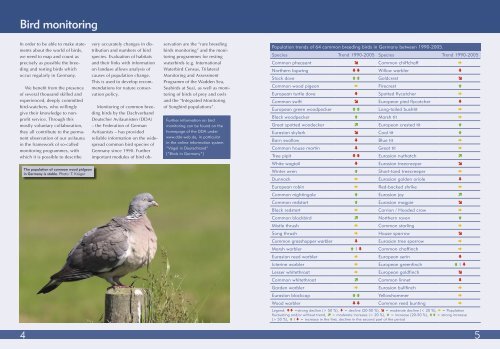Birds and Biodiversity in Germany - Bundesamt für Naturschutz
Birds and Biodiversity in Germany - Bundesamt für Naturschutz
Birds and Biodiversity in Germany - Bundesamt für Naturschutz
Create successful ePaper yourself
Turn your PDF publications into a flip-book with our unique Google optimized e-Paper software.
Bird monitor<strong>in</strong>g<br />
In order to be able to make statements<br />
about the world of birds,<br />
we need to map <strong>and</strong> count as<br />
precisely as possible the breed<strong>in</strong>g<br />
<strong>and</strong> rest<strong>in</strong>g birds which<br />
occur regularly <strong>in</strong> <strong>Germany</strong>.<br />
We benefit from the presence<br />
of several thous<strong>and</strong> skilled <strong>and</strong><br />
experienced, deeply committed<br />
bird-watchers, who will<strong>in</strong>gly<br />
give their knowledge to nonprofit<br />
service. Through this<br />
mostly voluntary collaboration,<br />
they all contribute to the permanent<br />
observation of our avifauna<br />
<strong>in</strong> the framework of so-called<br />
monitor<strong>in</strong>g programmes, with<br />
which it is possible to describe<br />
The population of common wood pidgeon<br />
<strong>in</strong> <strong>Germany</strong> is stable. Photo: T. Krüger<br />
very accurately changes <strong>in</strong> distribution<br />
<strong>and</strong> numbers of bird<br />
species. Evaluation of habitats<br />
<strong>and</strong> their l<strong>in</strong>ks with <strong>in</strong>formation<br />
on l<strong>and</strong>use allows analysis of<br />
causes of population change.<br />
This is used to develop recommendations<br />
for nature conservation<br />
policy.<br />
Monitor<strong>in</strong>g of common breed<strong>in</strong>g<br />
birds by the Dachverb<strong>and</strong><br />
Deutscher Avifaunisten (DDA)<br />
– the Federation of German<br />
Avifaunists – has provided<br />
reliable <strong>in</strong>formation on the widespread<br />
common bird species of<br />
<strong>Germany</strong> s<strong>in</strong>ce 1990. Further<br />
important modules of bird ob-<br />
servation are the “rare breed<strong>in</strong>g<br />
birds monitor<strong>in</strong>g” <strong>and</strong> the monitor<strong>in</strong>g<br />
programmes for rest<strong>in</strong>g<br />
waterbirds (e.g. International<br />
Waterbird Census, Trilateral<br />
Monitor<strong>in</strong>g <strong>and</strong> Assessment<br />
Programm of the Wadden Sea,<br />
Seabirds at Sea), as well as monitor<strong>in</strong>g<br />
of birds of prey <strong>and</strong> owls<br />
<strong>and</strong> the “Integrated Monitor<strong>in</strong>g<br />
of Songbird populations”.<br />
Further <strong>in</strong>formation on bird<br />
monitor<strong>in</strong>g can be found on the<br />
homepage of the DDA under<br />
www.dda-web.de, <strong>in</strong> particular<br />
<strong>in</strong> the onl<strong>in</strong>e <strong>in</strong>formation system<br />
“Vögel <strong>in</strong> Deutschl<strong>and</strong>”<br />
[“<strong>Birds</strong> <strong>in</strong> <strong>Germany</strong>”]<br />
Population trends of 64 common breed<strong>in</strong>g birds <strong>in</strong> <strong>Germany</strong> between 1990-2005.<br />
Species Trend 1990-2005 Species Trend 1990-2005<br />
Common pheasant � Common chiffchaff �<br />
Northern lapw<strong>in</strong>g �� Willow warbler �<br />
Stock dove �� Goldcrest �<br />
Common wood pigeon � Firecrest �<br />
European turtle dove � Spotted flycatcher �<br />
Common swift � European pied flycatcher �<br />
European green woodpecker �� Long-tailed bushtit �<br />
Black woodpecker � Marsh tit �<br />
Great spotted woodecker � European crested tit �<br />
Eurasian skylark � Coal tit �<br />
Barn swallow � Blue tit �<br />
Common house mart<strong>in</strong> � Great tit �<br />
Tree pipit �� Eurasian nuthatch �<br />
White wagtail � Eurasian treecreeper �<br />
W<strong>in</strong>ter wren � Short-toed treecreeper �<br />
Dunnock � Eurasian golden oriole �<br />
European rob<strong>in</strong> � Red-backed shrike �<br />
Common night<strong>in</strong>gale � Eurasian jay �<br />
Common redstart � Eurasian magpie �<br />
Black redstart � Carrion / Hooded crow �<br />
Common blackbird � Northern raven �<br />
Mistle thrush � Common starl<strong>in</strong>g �<br />
Song thrush � House sparrow �<br />
Common grasshopper warbler � Eurasian tree sparrow �<br />
Marsh warbler � I � Common chaff<strong>in</strong>ch �<br />
Eurasian reed warbler � European ser<strong>in</strong> �<br />
Icter<strong>in</strong>e warbler � European greenf<strong>in</strong>ch � I �<br />
Lesser whitethroat � European goldf<strong>in</strong>ch �<br />
Common whitethroat � Common l<strong>in</strong>net �<br />
Garden warbler � Eurasian bullf<strong>in</strong>ch �<br />
Eurasian blackcap �� Yellowhammer �<br />
Wood warbler �� Common reed bunt<strong>in</strong>g �<br />
Legend: �� =strong decl<strong>in</strong>e (> 50 %), � = decl<strong>in</strong>e (20-50 %), � = moderate decl<strong>in</strong>e (< 20 %), � = Population<br />
fluctuat<strong>in</strong>g <strong>and</strong>/or without trend, � = moderate <strong>in</strong>crease (< 20 %), � = <strong>in</strong>crease (20-50 %), �� = strong <strong>in</strong>crease<br />
(> 50 %), � I � = <strong>in</strong>crease <strong>in</strong> the first, decl<strong>in</strong>e <strong>in</strong> the second part of the period<br />
4 5

















